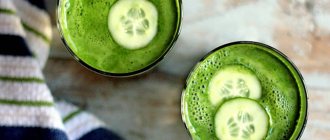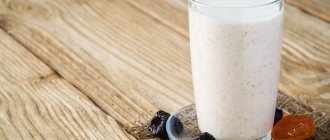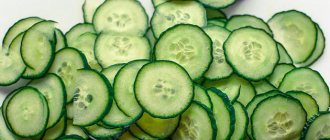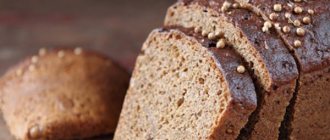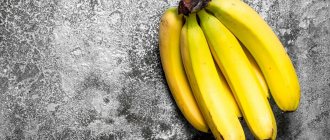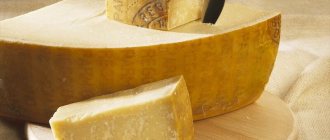Kefir is a fermented milk product that is fermented from cow's milk using fungi. The drink is thick, white, with a slight release of carbon dioxide. People love it for its taste, low calorie content and availability. Fermented milk drink can be bought in any store; it has a low, attractive price.
Kefir varies in fat content: low-fat (1%), as well as 2.5% and 3.5%. In terms of alcohol content, it can be strong (0.6%), medium (0.4%), and weak (0.2%). According to the fermentation time: one-, two-, and three days. Manufacturers add fruit syrups, lacto- and bifidobacteria to the drink. Obviously, the benefits and harms of kefir are incommensurable, but who shouldn’t drink a fermented milk drink?
General information
The drink is prepared from skim or whole milk by alcoholic or fermented milk fermentation using special fungi.
Sourdough contains about 20 organisms, including streptococci, lactobacilli, acetic acid bacteria and yeast. Now the food industry also offers a type of drink called biokefir. During its production, special starter preparations are added to the product. They contain acidophilus bacilli and bifidobacteria, which do not dissolve under the action of gastric juice, but directly enter the intestines. Being a natural component of its microflora, they inhibit the activity of pathogenic bacteria.
Kefir has probiotic properties - it has a beneficial effect on the gastrointestinal tract and improves metabolism.
The nutritional value
For a classic drink with a fat content of 2.5%, it is 53 kcal per 100 g of product.
The ratio of proteins, fats and carbohydrates is 2.9 g, 2.5 g and 4 g, respectively. Amount of water – 89 g. Kefir contains:
- vitamins H, PP, A, C and group B;
- minerals – calcium, phosphorus, cobalt, molybdenum, iodine, potassium, chlorine, sodium, etc.
Vitamins and minerals contained in kefir.
Results
Kefir is a low-calorie drink that contains beneficial bacteria that have a beneficial effect on the functioning of the intestines and digestion in general. With the help of kefir, you can lose weight, cleanse the body of toxins and impurities, improve overall well-being and get rid of puffiness.
The drink is useful to drink in the morning on an empty stomach and before bed. It can be consumed either alone or together with other ingredients, for example, buckwheat, flaxseeds, oatmeal, cinnamon, etc. Kefir is useful to drink after sports to saturate the body with energy, satisfy hunger and strengthen muscle tissue.
Differences between adult and children's kefir
A children's drink differs from an adult drink in having less acidity and fat content.
Classic kefir can cause vomiting or indigestion in a child. The baby’s body is not yet able to cope with sour foods, so the baby drink is made to have a milder taste. In addition, a child under 3 years of age has not yet developed enzymes that help digest high-fat foods. For the production of children's kefir, only the highest grade milk is used, while the first grade is suitable for adult products.
Nutritionists recommend introducing the classic drink into a child’s diet only from the 3rd year of life.
The benefits of kefir for children
The product has a beneficial effect on the children's body:
- restores intestinal microflora;
- prevents gastrointestinal diseases;
- supplies the body with essential vitamins and minerals;
- strengthens the immune system;
- improves appetite;
- helps with sleep disorders.
According to research, a child’s digestive system absorbs protein from kefir better than from milk.

The beneficial effects of kefir on the child’s body.
Indications for use
Pediatricians recommend drinking the drink for children who suffer from intestinal dysbiosis, constipation, anemia, rickets, and immunodeficiency pathologies. It is able to provide the body with calcium necessary for the growth of the baby’s bones. It is believed that in cases of lactose intolerance, kefir can replace milk in a child’s diet.
Taking fermented milk products for therapeutic purposes should be discussed with your doctor.
Beneficial and healing properties for the body
Kefir of different fat contents has beneficial and healing properties for the female and male body. The drink is useful to drink both in the morning as a complement to the main dish, for example, buckwheat or oatmeal, for quick saturation, and at night to improve digestion and sleep.
Drinking 1-2 glasses of kefir every day has a healing effect on human health, namely:
- The functioning of the gastrointestinal tract improves. Thanks to the probiotics included in the drink, you can cure indigestion, eliminate constipation (thanks to the laxative properties of kefir) and restore normal digestive function after taking a course of antibiotics.
- Symptoms of diseases such as ulcerative colitis, irritable bowel syndrome and Crohn's disease are reduced. In addition, the drink can be drunk to prevent stomach and duodenal ulcers.
- Kefir is a preventative against infections such as Helicobacter, E. coli, and salmonella.
- The risk of developing osteoporosis is reduced, bones are strengthened.
- The risk of malignant formations and the appearance of cancer cells is reduced.
- The symptoms of allergies and asthma are reduced.
- The intestines and liver are cleansed of toxins, waste, and salts.
- The weight loss process accelerates.
- Swelling decreases. Excess fluid is removed from the body due to the diuretic properties of the drink.
- The functioning of the cardiovascular system improves. Blood pressure is normalized and the level of bad cholesterol in the blood is reduced, which reduces the likelihood of developing thrombosis.
Kefir can be drunk by people with lactose intolerance. The drink is useful for athletes after physical activity, as it helps to quickly restore strength, satisfy hunger and fill the body with energy. In addition, the protein contained in the composition helps build muscle mass.
Note: after an exhausting physical workout, it is necessary to saturate the body not only with proteins, but also with carbohydrates. To do this, athletes are recommended to make a protein shake from kefir with the addition of banana.
Women use kefir for cosmetic purposes. It is used to make nourishing masks for the face and hair roots. The drink relieves skin redness and relieves pain from sunburn.
Low-fat kefir has the same health benefits as a 1% fat drink, but contains fewer calories and no fat.
When and how to introduce kefir into the diet
Kefir is introduced into the baby's diet gradually.
With artificial feeding, it can be fed to a 7-month-old baby. The first time the child is given a teaspoon of the drink to try. With natural nutrition, complementary feeding with kefir begins a month later. Kefir should not be given to a child at night. Parents should monitor the child’s body’s reaction to new food. If a child develops allergies, problems with the gastrointestinal tract, or shortness of breath, you should stop taking kefir. If you experience the last symptom, you should immediately consult a doctor.
If there were no negative reactions, you can continue to get acquainted with the product the next day.
It must be remembered that the drink contains calcium, and if the crown becomes overgrown at a rapid pace, complementary feeding should be postponed until the age of one year.

Kefir is introduced into baby's complementary foods gradually, starting with a teaspoon.
Consumption standards
Starting with a teaspoon per day, the amount of kefir is gradually increased to 100 ml for babies aged 9–10 months.
By the age of one year, the volume of drink consumed can reach 200 ml per day. After the first 12 months of life, other dairy products appear in the child’s diet - cheeses, cottage cheese and sour cream. Therefore, for up to 3 years, the amount of kefir consumed per day remains at the same level - 200 ml.
Use in cooking
Thanks to its refreshing taste, kefir is often used to prepare cold soups: okroshka, beetroot soup, Lithuanian borscht. You can even use this drink when cooking first courses: try replacing half of the water with kefir, which should be added 10–15 minutes before the soup is ready. You may be pleasantly surprised by a new unusual taste.
Kefir is also good in hot dishes: it is added when stewing meat, baking fish and vegetables, and marinating poultry in it. Based on this product, sauces and various desserts are prepared, pancakes, pancakes and pies are baked.
Kefir recipes
Kefir can be prepared at home.
This allows you to control the quality of the ingredients and the fermented milk product itself. The main components are milk and a special starter, which is sold in pharmacies. In home recipes, the latter is often replaced with sour cream or a ready-made drink.
With cow's milk
Ingredients:
- milk – 1 l;
- sourdough – 1 tbsp. l.
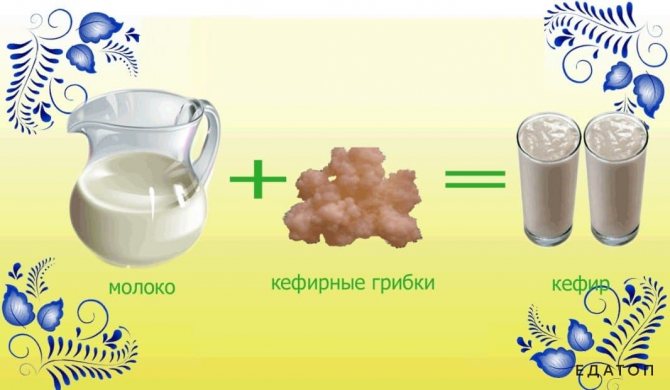
Recipe for making homemade kefir with cow's milk.
Cooking steps:
- The milk is boiled and allowed to cool to a temperature slightly above room temperature.
- Add the starter and, covering the mass with gauze or cloth, put it in a warm place, protected from direct sunlight. Do not use a lid to prevent the fungus from suffocating and dying.
- After 10 hours, the contents of the jar are stirred.
- After a day, if the milk has thickened, the product is ready. It is filtered and poured into a container for storage.
Instead of sourdough with fungus, you can use 50 ml of ready-made homemade kefir.
With sour cream sourdough
Ingredients:
- milk – 500 ml;
- sour cream – 2 tbsp. l.
Cooking sequence:
- The milk is boiled, allowed to cool, and poured into a glass container.
- Separately prepare the starter. Mix sour cream and 50 ml of milk thoroughly and pour the mixture into a jar.
- The container is removed for 24 hours in a warm place.
After a day, the product is ready for use. It should be stored in the refrigerator.
Harm to health and contraindications
Consuming low-quality kefir or a drink with an expired kefir risk of food poisoning.
Contraindications to drinking fermented milk drink are as follows:
- allergy;
- exacerbation of gastritis;
- ulcer in the acute stage with high acidity;
- poisoning;
- gastrointestinal infection.
Drinking homemade three-day kefir is not recommended for people with exacerbation of any stomach or intestinal diseases and those who suffer from kidney diseases.
You cannot follow a diet in which breakfast consists of buckwheat and kefir for more than two weeks in a row. Exceeding the recommended period may cause deterioration in health, namely headaches, weakness in the body and fatigue.
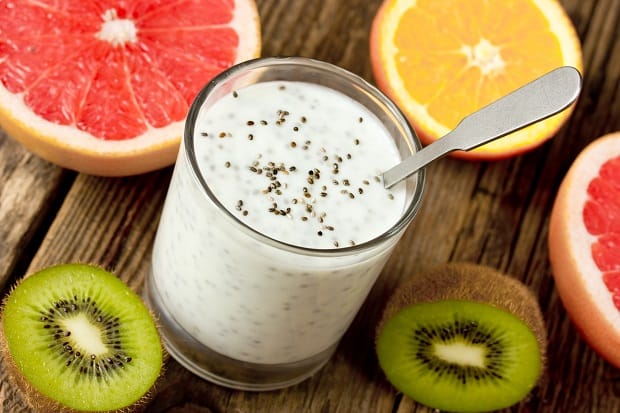
© san_ta — stock.adobe.com
Tips and tricks
Kefir can be given every day, but pediatricians and nutritionists recommend using it in the diet 2-3 times a week.
You should switch to evening feeding with a drink only after the child gets used to it. The product can be fed from a spoon or from a small cup.
You should not adhere to strict calendar schedules when introducing kefir into your child’s diet. If the baby’s body reacts negatively to the drink, there is nothing to worry about if its consumption is delayed for several months.
Origin
North Ossetia is considered the birthplace of kefir. Ossetians called this drink “a gift from heaven,” and the secret of its preparation was kept strictly secret. Foreigners could try kefir and appreciate its healing properties, but they were unable to find out how it was produced.
The fame of the invigorating and healthy fermented milk drink soon spread far beyond the Caucasus. In 1867, the first description of kefir as a medicinal and dietary drink appeared in one of the Russian medical journals. And already in 1907, the owner of the dairy plant Balandin established the production of kefir in Russia. How he ended up with the “secret” kefir grains, so jealously guarded by Ossetians, still remains a mystery.


